Text types: Recounts
| Sequencing events |
Focus on grammar
When we recount what happened
in the past, we usually sequence the events in the order in which they occurred
in real life. We can show the sequence of events in a recount, by sequencing them along a
time line. ![]()
Here are two clauses which tell about a sequence of events in the recount My day out at Ocean Park.
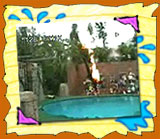 |
|
In recounts, however, speakers and writers often use the following words, groups and phrases to highlight the sequence in which the events happened:
 |
sequencing words, or connectives |
 |
noun groups and prepositional phrases, eg our first stop, at the end of an exhausting day |
Using sequencing words
The most commonly used sequencing word is and which is used to join clauses to make a sentence. In recounts each clause tells about an event and the word and is used to add each of these events one after the other.
Here are some examples from the recount My day out at Ocean Park.
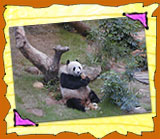 |
|
||||||||||||
If we use and to sequence more than two events in one sentence, we
use commas instead of the word and until we add the last event in the
sequence. If the subject of each event is the same, we often only use
the subject in the
first clause and leave it out in the following clauses, eg:
| doing clause | doing clause | doing clause | ||
|
1st event |
comma |
2nd event |
sequencing word |
3rd (and last) event |
| At about nine o'clock we arrived at Ocean Park | , | [we] bought our tickets | and | [we] went through the entrance. |
| Sophia bought some sweets | , | Lara bought a wallet | and | I bought a photo frame. |
The sequencing word so is often used to add the concluding event of
a series, ie the event caused by previous events or decisions, or the event the others were leading up to.
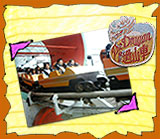 |
|
|||||||||||||||
In some kinds of writing we do not use the sequencing words and or so
at the beginning of sentences, eg in a general description or in a written
argument. When we tell stories such as recounts and narratives, however, we do
sometimes begin sentences with and or so if this enhances the
meanings in the story.
For example, in the following sentence from the recount My day out at Ocean Park, instead of joining the two clauses, the writer chose to put a full stop after the words not so fast and to begin a new sentence with the word so. The intrusion of the full stop between the clauses slows the story down and thus enhances the meaning of the words not so fast.
... we wanted to go on something which was not so fast. So Sophia, Lara and I went on a dizzy ride called the Eagle.
Other sequencing words include then and next. These words are not used to join clauses into a single sentence. Instead they are used to show that the sequence continues on from a separate preceding sentence, eg:
 |
|
||||||||
Sometimes we combine then and next with
sequencing words which join clauses together into one sentence, eg and then, but then, and then, so then, and next, but
next:
| doing clause | doing clause | |
| 1st event |
sequencing words |
2nd event |
|
The Dragon and the pirate ship were great |
but next |
we wanted to go on something which was not so fast. |
Some sequencing words can only be used to join clauses together into
a sentence, eg after, when, while. A clause which begins with one of
these words cannot be a complete sentence on its own. It must be dependent
on a main clause to make a complete sentence. In recounts these dependent
clauses are usually placed before the main clause. When dependent clauses are
placed before the main clause, they are followed by a comma.
| dependent clause | main clause | |
| sequencing word | 1st event | 2nd event |
|
After |
we went inside, | we decided to go to the high land where the fastest, scariest and best rides in the whole of Ocean Park are. |
|
When |
we stepped off the cable car, | we walked to the fast, fun rides. |
Usually in recounts we tell the events in the order in which they happened in
real life, as in this example from the recount My day out in Ocean Park.
| 1st event | 2nd event | |
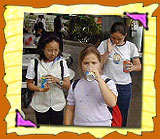 |
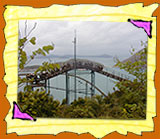
|
|
| dependent clause | main clause | |
| After | we had a snack, | Lara and I went on the Mine Train. |
Sometimes we put event 2 before event 1. If
we do this, we use the sequencing word before.
| dependent clause | main clause | |
| sequencing word | 2nd event | 1st event |
|
Before |
Lara and I went on the Mine Train, | we had a snack. |
In recounts we use the sequencing word while
to add an event which happened at the same time as the main event. Clauses which begin with while are dependent clauses.
 |
|
||||||||||||
The sequencing word as is also used to tell about events which
happened at the same time as the main event in a sentence.
| main clause | ... | main clause | |
| dependent clause | |||
| sequencing word |
event happening at the same time |
main event in the sentence | |
| At the entrance, |
as |
we were leaving, | we saw the divers from the high diving show dressed normally. |
Using noun groups and prepositional phrases to sequence events
Sometimes noun groups ![]() are used to sequence events in time
in recounts:
are used to sequence events in time
in recounts:
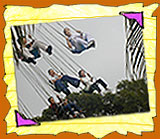 |
|
|||||||||
Sometimes prepositional phrases ![]() are also used:
are also used:
 |
|
||||||||||||||||||||
In the RE-ORIENTATION
stage of the recount My day out in Ocean Park a prepositional phrase brings the sequence of
events to an end. ![]()
|
doing clause |
|||
|
sequencing prepositional phrase |
|
||
| At the end of the exhausting day | we | went | into a souvenir shop. |
| To see how sequencing words, noun groups and prepositional phrases are used to sequence events in the recount My day out at Ocean Park, click here: | 
|
For more information see:
|
||
To give us feedback about this section, click here or on the Comment button at the top of the screen.
If you have any questions about this section, visit the Language Corner.
If you have any questions or suggestions about how to teach this section, send a message to the Teaching Corner.